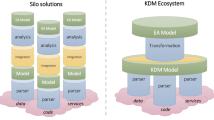Abstract
The Knowledge-Acquisition (KA) community necessities demand more effective ways to elicit knowledge in different environments. Methodologies like CommonKADS [8], MIKE [1] and VITAL [6] are able to produce knowledge models using their respective Conceptual Modeling Languages (CML). However, sharing and reuse is nowadays a must-have in knowledge engineering (KE) methodologies and domain-specific KA tools in order to permit Knowledge-Based System (KBS) developers to work faster with better results, and give them the chance to produce and utilize reusable Open Knowledge Base Connectivity (OKBC)-constrained models. This paper presents the KAMET II1 Methodology, which is the diagnosis-specialized version of KAMET [2,3], as an alternative for creating knowledge-intensive systems attacking KE-specific risks. We describe here one of the most important characteristics of KAMET II which is the use of Protégé 2000 for implementing its CML models through ontologies.
Preview
Unable to display preview. Download preview PDF.
Similar content being viewed by others
References
Angele, J., Fensel, D., Studer, R.: Developing Knowledge-BASED Systems with MIKE. Journal of Automated Software Engineering
Cairó, O.: A Comprehensive Methodology for Knowledge Acquisition from Multiple Knowledge Sources. Expert Systems with Applications 14, 1–16 (1998)
Cairó, O.: The KAMET Methodology: Content, Usage and Knowledge Modeling. In: Gaines, B., Musen, M. (eds.) Proceedings of the 11th Banff Knowledge Acquisition for Knowledge-Based Systems Workshop. Department of Computer Science, University of Calgary, pp. 1–20. SRGD Publications, Calgary
Cairó, O., Barreiro, J., Solsona, F.: Software Methodologies at Risk. In: Fensel, D., Studer, R. (eds.) EKAW 1999. LNCS (LNAI), vol. 1621, pp. 319–324. Springer, Heidelberg (1999)
Cairó, O., Barreiro, J., Solsona, F.: Risks Inside-out. In: Cairó, O., Cantú, F.J. (eds.) MICAI 2000. LNCS(LNAI), vol. 1793, pp. 426–435. Springer, Heidelberg (2000)
Domingue, J., Motta, E., Watt, S.: The Emerging VITAL Workbench
Medsker, L., Tan, M., Turban, E.: Knowledge Acquisition from Multiple Experts:Problems and Issues. Expert Systems with Applications 9(1), 35–40
Schreiber, G., Akkermans, H.: Knowledge Engineering and Management: the CommonKADS Methodology. MIT Press, Cambridge (1999)
Schreiber, G., Crubézy, M., Musen, M.: A Case Study in Using Protégé-2000 as a Tool for CommonKADS. In: Dieng, R., Corby, O. (eds.) EKAW 2000. LNCS (LNAI), vol. 1937, pp. 33–48. Springer, Heidelberg (2000)
van der Gaag, L., Helsper, E.: Experiences with Modeling Issues in Building Probabilistic Networks. In: Gómez-Pérez, A., Benjamins, V.R. (eds.) EKAW 2002. LNCS (LNAI), vol. 2473, pp. 21–26. Springer, Heidelberg (2002)
Author information
Authors and Affiliations
Editor information
Editors and Affiliations
Rights and permissions
Copyright information
© 2003 Springer-Verlag Berlin Heidelberg
About this paper
Cite this paper
Cairó, O., Alvarez, J.C. (2003). KAMET II: An Extended Knowledge-Acquisition Methodology. In: Palade, V., Howlett, R.J., Jain, L. (eds) Knowledge-Based Intelligent Information and Engineering Systems. KES 2003. Lecture Notes in Computer Science(), vol 2773. Springer, Berlin, Heidelberg. https://doi.org/10.1007/978-3-540-45224-9_12
Download citation
DOI: https://doi.org/10.1007/978-3-540-45224-9_12
Publisher Name: Springer, Berlin, Heidelberg
Print ISBN: 978-3-540-40803-1
Online ISBN: 978-3-540-45224-9
eBook Packages: Springer Book Archive




